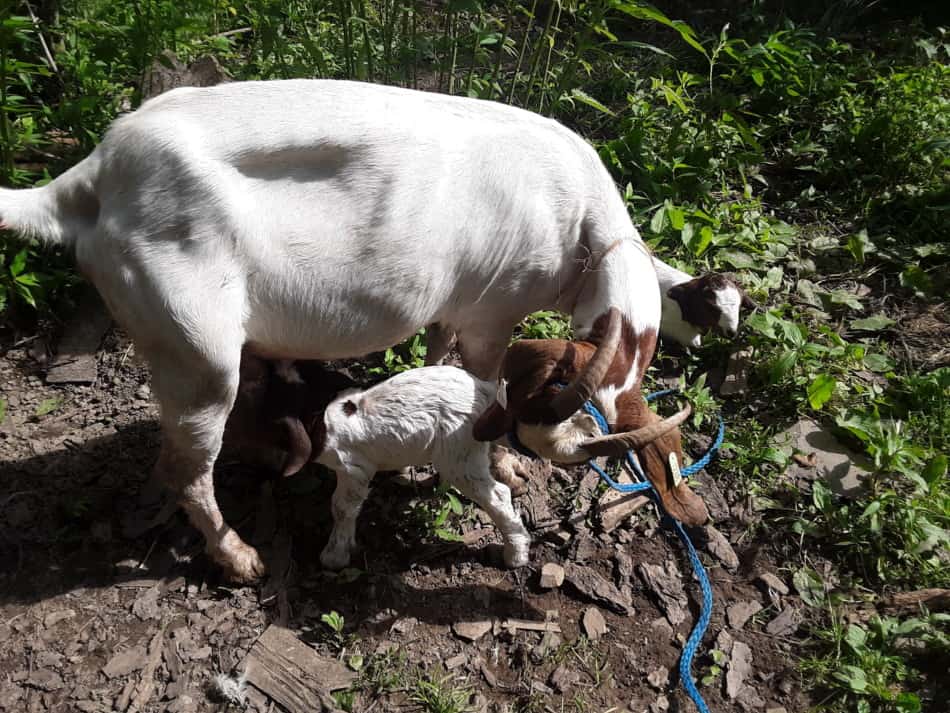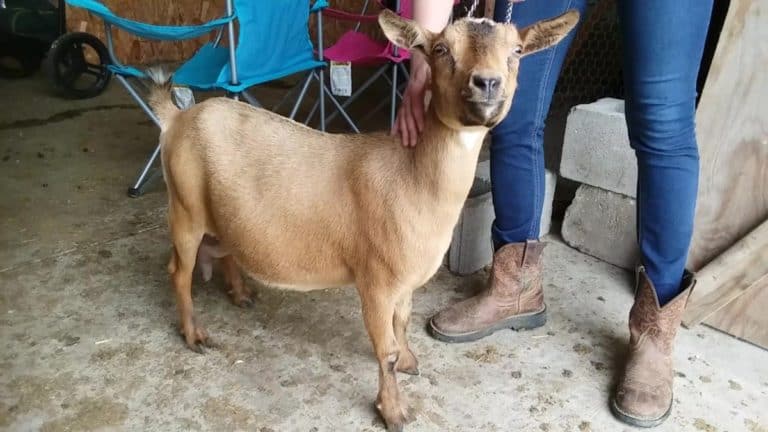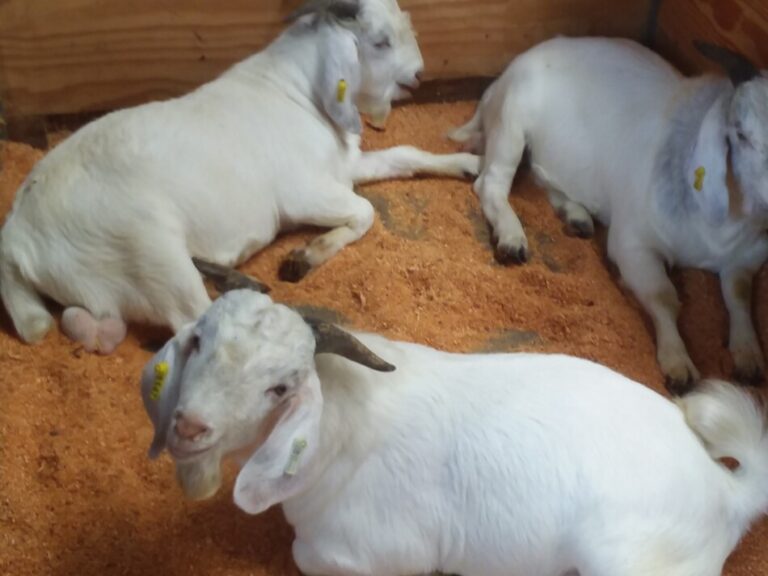Growing Your Goat Herd: 8 Things You Need To Know

Goats are fun and full of personality, it’s no wonder that they are growing in popularity! And the baby goats, they’re such characters!
Here are the things you’ll need to know about getting started raising goat kids to have fun and be successful!
Start with healthy breeding stock, both bucks and does. Keep back your own replacement doelings, they are adapted to your farm.
Who doesn’t love a baby goat? I really get a kick out of them, they are so spunky!
Actually, I get far more attached to them than I should, since we make our living raising and selling livestock!
Something about baby goats really gets to me, down deep. As much as I love their antics and full of life attitude, I am equally affected when one gets sick or worse yet dies!
This is why it’s so important to start out right and take a little caution to set yourself and your goats up for success.
If you are wanting information focused on the cost of getting started in meat goats, read my article Thinking Of Getting Into Meat Goats? The Costs Of Getting Started.
| Gestation Length | 150 days (5 months) |
| Number of kids | 1-3 are most likely, twins common |
| Size of doeling to breed | 80% of adult weight |
| Pregnancies per year | 1 is common 1.5 with high management |
| Age to breed doelings | based on weight not age |
| Breeding age of bucklings | castrate all bucklings by 2 months of age buy a mature buck for breeding |
Start with healthy breeding stock
Starting out with healthy breeding stock is the key. Frankly, it is impossible to over emphasize this point.
I realize that high quality goats are going to cost more to purchase, but as the saying goes “quality pays.”
A more accurate version might be “quality repeatedly pays.”
If you already have some goats and are looking to start breeding them, make sure they are in ideal condition first.
Too fat or too thin are both compromising health and reproduction.
How is your management, specifically deworming? Nothing will sink your goats ability to be healthy (and therefore happy) like a heavy parasite load.
Starting out with high quality breeding stock is step one, you keeping that stock in good shape and health is your ongoing step two.
Looking for more details on the business aspect of raising goats? Check out my article Are Meat Goats A Profitable Small Farm Business?
Age to breed goats
Goats have the ability to breed sooner than you may think. Uncastrated young bucks running with the herd can give you some breeding surprises.
Kidding is always a time to look forward to, but having unplanned inbred kids is not the way to successfully increase your herd.
Uncastrated young males-not breeding quality!
Why? First off, just because a buck is not castrated does not make him breeding quality!
Nothing, nothing, nothing will influence the genetics of your future herd like the buck you use now.
Why not set yourself up to have a great goat herd in a few years by planning and carefully selecting a buck now?
Raising your own buck
Short answer: Don’t do it. Buy a buck from someone with experience.
Long answer: Raising breeding stock is challenging. Requiring years of culling at all stages of growth to keep the best performers.
Even then, not all goats will turn out the way you hope they will.
You don’t really know what a buck is going to do for a year, or two! Kids younger that that are maybes (at best).
Since you’re new, you don’t have the experience yet to make good guesses.
Buy a breeding age buck from someone who has a good reputation whose goats you like.
Doeling breeding age and size
Doelings are a bit different than bucks, as far as breeding age. For doelings, it’s really more about breeding size, generally measured by weight.
The doeling should be at 80% of her adult weight before allowing her to be bred.
Why? A doeling needs the extra time to grow and reach her full genetic potential before she becomes a mom.
Giving her a few extra months to grow before breeding will make her more likely to have a successful pregnancy and be a better mom.
If she still has a lot of growing yet to do, it’s unlikely that she will be able to keep up the growth she needs herself while supporting the pregnancy.
Months of gestation for a goat
The normal goat gestation is 5 months (150 days). There will be some wiggle room in the due dates even if you saw the doe or doeling being bred.
Noting the breeding date on the calendar is always a good idea, but is not a guarantee of the kidding date! Be ready for babies a week or so ahead of schedule and up to a week or so after the due date.
Number of pregnancies per year
If you are just looking at a calendar, it looks like a doe can have multiple full term pregnancies per year. In reality, it is not the case.
The best you could do, as far as a kidding rate, is more like 3 kiddings in two years.
Sometimes, an idea looks good on paper and the numbers work out great in your budget, but that does not mean it’s a good idea in reality.
This is one of those times.
Does need to rebuild before breeding
A doe needs some time between pregnancies to rest up and rebuild her body reserves to take care of herself and the babies for the next pregnancy and lactation (milking) period.
Back to back breedings with no rest period in between, can be hard on the does.
Such an intensive breeding schedule will require perfect management on your part, super high performance leaves no room for error.
The catch: there is no such thing as perfect, livestock management changes daily, sometimes hourly.
Give yourself and your does the best chance of having a successful kidding season by having well rested does in top condition.
Can you breed a doe and son?
Technically the answer is yes. You can breed a doe (mother goat) to her son.
However, the question you should be asking is, should you breed a doe to her son? That answer is no, you should not.
Breeding closely related animals is called inbreeding. Inbreeding increases the likelihood of genetic problems cropping up in the kids.
Any genetics will be concentrated when breeding relatives, the good genetics and the bad genetics.
For small farm goat producers inbreeding is a poor management decision, don’t do it.
I have to admit there are times when inbreeding, while always risky, is appropriate.
For instance when there are only very few closely related individuals left alive from a specific breed, then inbreeding is the only option to keep the breed from dying out.
This is a rare and unusual situation that requires a rare and unusual answer.
Unless you literally have the last few goats in the world of a specific breed, inbreeding is not the solution to getting your does and doelings bred.
Buy a buck from an unrelated herd.
Will my goat have twins?
Twins are very common in goats. Will your does all have twins, no, they won’t.
We had two does kid this year (we’re just getting going with goats) and one had twins the other had a single.
It seems that the closer the birth is to the normal time of year for wildlife babies to be born, like deer, the more likely it is that your goats will have the higher number of babies.
Off season births are always nice but tend to not produce as high of a birth rate as the normal birth times, which in this part of the world is spring.
How can you tell if a doe is bred?
The best way to tell if a doe or doeling is bred is to keep track of her heat cycle on a calendar. Write down a breeding date as well, if you have it.
Now look on the calendar for the date 21 days from now and make a notation to remind yourself to check this doe on this day.
If you want a more accurate answer, you’ll need to have an ultrasound done or have a blood test taken and read.
How much will it cost to keep kids instead of sell them?
Here is a consideration most people do not think to work out for the goat budget.
Any goat that you keep back for breeding increases your immediate costs to keep your goats for the year and decreases the income you are getting in from your goats for the year. It’s a double whammy!
To be clear, I think keeping back replacement doelings or just herd expansion doelings from your own kids is a super idea.
By keeping your own kids you get to choose how they are raised for their entire lives, not just how they are taken care of once you buy them.
Kids raised at your farm will be better adapted to your area than a replacement doe or doeling you would purchase.
That’s the good news. The challenging part of that good news is not getting the money for the market kid since you didn’t sell it!
Plus it’s another eater to feed and take care of until her babies are ready to sell, in anther year and a half or so!
Is it worth the expense to keep back your own replacements? Run the numbers and see.
My favorite goat info source
My favorite goat information source is Onion Creek Ranch run by Suzanne W. Gasparotto of Texas. Wow, there is a ton of stuff here! Check it out.
Look under the Meat Goat Mania tab on the right hand side, it will take you to her articles on raising and caring for goats.




